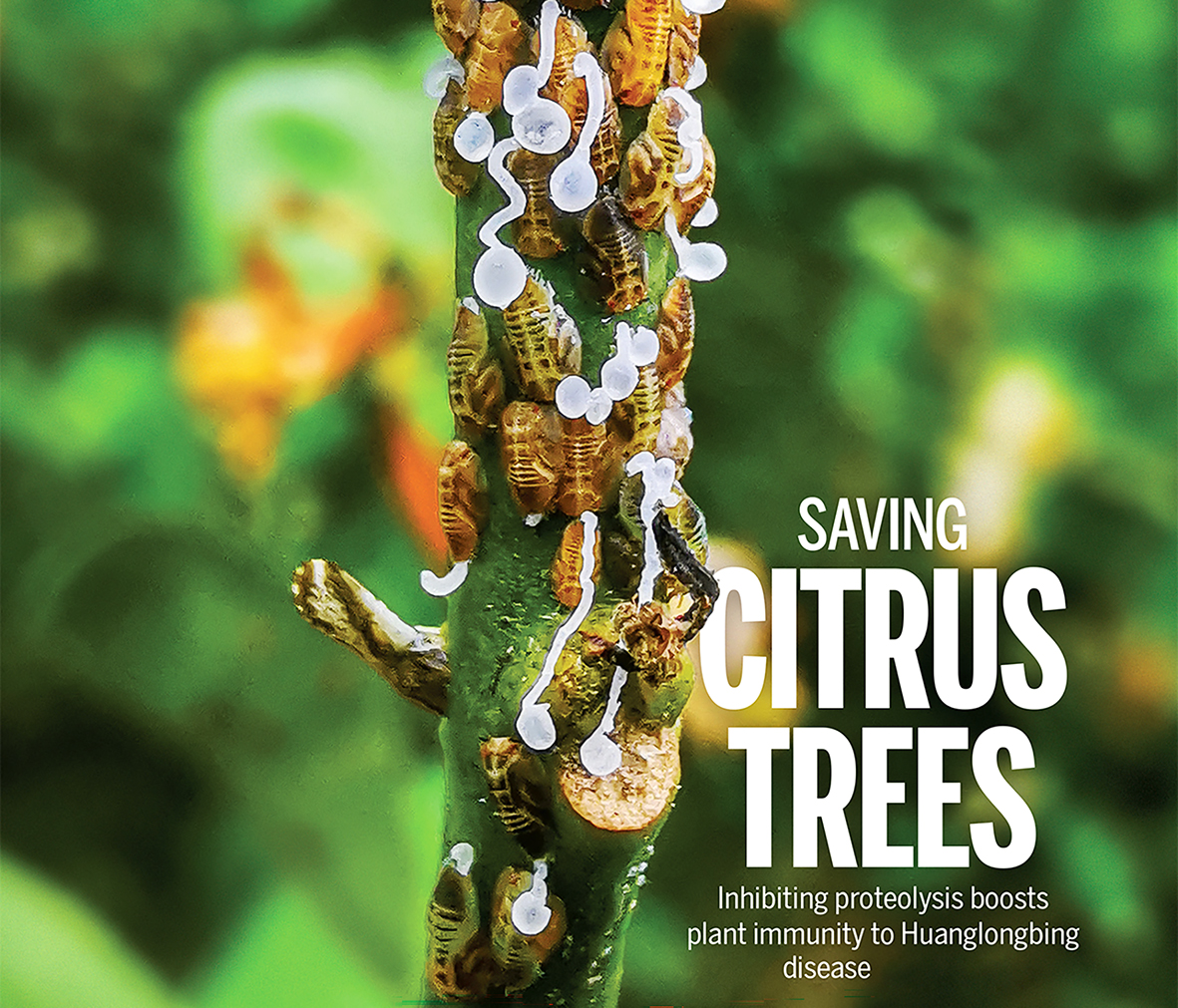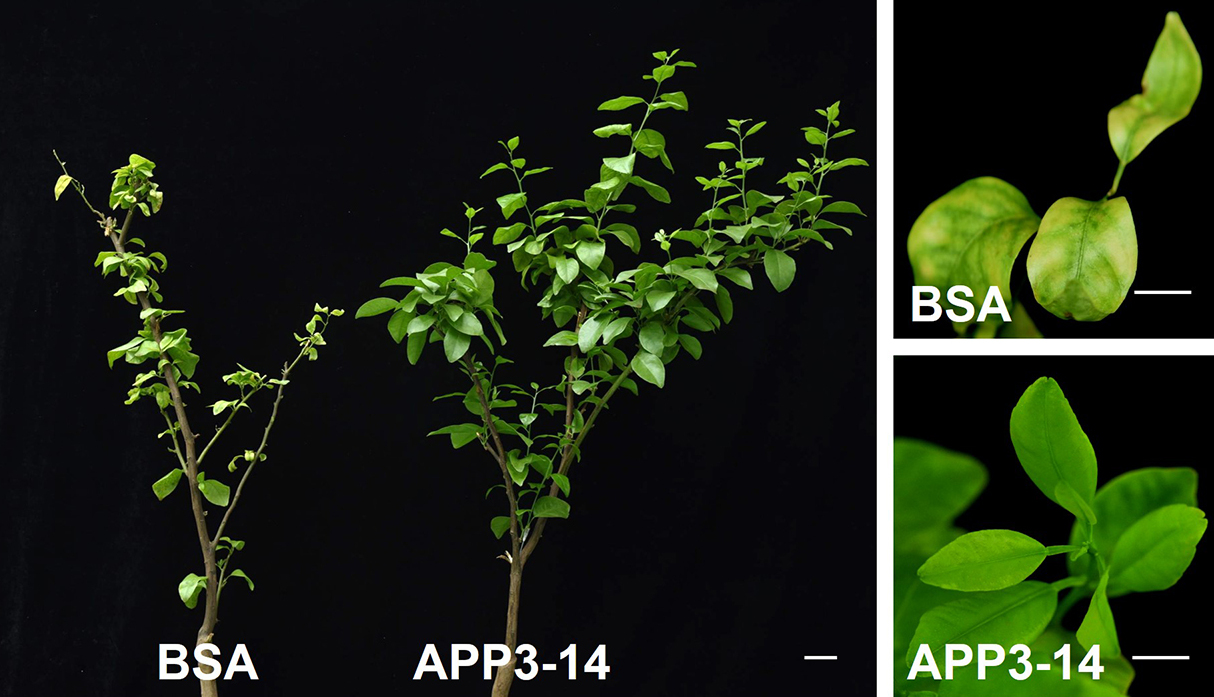By YAN Fusheng
A devastating disease called Huanglongbing (HLB) or citrus green is wiping out citrus trees across the globe. But we are seeing new hope. Scientists have recently uncovered a hidden battle happening inside citrus plants. Understanding this microscopic tug-of-war could be the key to rescuing our beloved oranges, lemons, and grapefruits.
Huanglongbing (HLB), also known as citrus greening, is a destructive bacterial disease attacking citrus groves worldwide. It’s mainly caused by a bacterium, Candidatus Liberibacter asiaticus (CLas), which spreads through tiny insects called Asian citrus psyllids. This bacterium clogs up the plant’s “food delivery system” (the phloem—tiny tubes that carry sugars, proteins, and amino acids), essentially crippling the trees’ delivery system and “starving” them to death.
The Grim Outlook and a Glimmer of Hope
The disease manifests its destructiveness in devastating ways: leaves develop a blotchy, uneven yellowing pattern (sometimes described as resembling a “yellow dragon” coiled on the leaves), fruits are often small, misshapen, fail to ripen properly, and may taste bitter (earning them names like “red-nosed fruit” due to uneven coloring), and the entire tree progressively loses its vigor, eventually leading to a systemic decline.
Currently, farmers can only rely on “three measures” to deal with it: using disease-free seedlings, applying insecticide, and cutting down trees. However, these methods are troublesome and usually prove ineffective, and the pathogen continues to spread rampantly, delivering a fatal blow that results in dead trees and ruined orchards.
HLB has already caused billions of dollars in economic losses, leaving behind withered trees and abandoned orchards. So far, finding effective treatments or popular citrus varieties (like sweet oranges, mandarins, lemons, and grapefruits) that can naturally resist the disease has been extremely difficult. Once infected, citrus trees are usually doomed within a few years.

Huanglongbing (HLB), also known as citrus greening, is a deadly bacterial disease spread via Asian citrus psyllid insects, and causes $10 billion in annual crop losses by killing trees within years of infection. Scientists have discovered natural plant defenses against HLB and engineered therapeutic peptides showing potential to rescue infected trees. (Photo by WANG Xuefeng)
Despite the grim outlook, some wild citrus relatives show a natural ability to tolerate or even resist HLB. Scientists have been diligently studying these resilient plants, trying to uncover the molecular secrets that make them so tough.
The Breakthrough: Unmasking a Cellular Culprit and a Hero
A new study, published in the journal Science on April 11, 2025, shines a light on a crucial control system within citrus plants. A research team led by Dr. YE Jian from the Institute of Microbiology of the Chinese Academy of Sciences has pinpointed how a delicate balance inside the plant’s cells determines if it gets sick or stays healthy.
They discovered a specific protein called PUB21 in citrus plants, which acts as a key “Bad Guy” making them vulnerable to HLB. This protein functions much like a cellular “demolition worker,” tasked with marking certain proteins for destruction by the cell’s recycling machinery. Researchers found that the gene instructing the plant to produce PUB21 is significantly more active in HLB-infected, susceptible sweet oranges compared to more tolerant citrus types, indicating that higher levels of PUB21 correspond to sicker trees. Further proving PUB21’s role in the disease, when scientists genetically modified citrus plants to produce extra PUB21, these plants exhibited worse HLB symptoms and harbored more bacteria.
Intriguingly, the team also identified a “Good Guy” in some resistant citrus distant relatives in the Rutaceae family: a slightly different, mutated version of PUB21, which they termed PUB21DN. This PUB21DN behaves like a “faulty demolition worker”; it doesn’t perform its originally intended job correctly, but critically, it obstructs and prevents the normal, harmful PUB21 from functioning properly, much like a broken gear jamming up a machine. When scientists introduced this protective PUB21DN into susceptible citrus plants, the plants showed a marked increase in resistance to HLB, with some even achieving complete immunity despite exposure to infected insects.
How the “Bad Guy” Works: Destroying a Defense Commander
So, what does the harmful PUB21 do to make plants sick? The scientists discovered that PUB21 targets another crucial protein called MYC2. Think of MYC2 as a central “defense commander” within the plant, responsible for activating the plant’s defense systems, particularly those mediated by a plant hormone known as jasmonate, which acts like a chemical “call to arms” to rally the plant’s defenses against threats like pests and diseases. The detrimental effect of the harmful PUB21 is that it “tags” this defense commander, MYC2, for destruction. In contrast, the beneficial mutated version, PUB21DN, does not efficiently tag MYC2 and physically prevents the harmful PUB21 from doing so.
The consequence of this interaction is stark: in susceptible plants with high levels of the harmful PUB21, the defense commander MYC2 is rapidly destroyed, leading to a weakened jasmonate defense system and consequently, a sicker plant. Conversely, in resistant plants, or those engineered to produce the helpful PUB21DN, MYC2 is protected, resulting in higher levels of jasmonate defense, allowing the plant to more effectively combat the disease.
“PUB21 and PUB21DN are like a pair of ‘brothers’ with completely different personalities,” explained Dr. YE Jian. “The former is a ‘traitor’ in the plant’s disease resistance immune network, suppressing disease-resistance genes; the latter is a ‘guardian’ that can control PUB21, allowing MYC2 to normally perform its bacteria-killing function.”
An Evolutionary Twist and a Bacterial Sabotage
This dynamic is further influenced by an evolutionary twist and bacterial sabotage. Susceptible citrus varieties often have an extra piece of “jumping DNA” (a helitron) near the PUB21 gene. This extra DNA accidentally helps the defense commander MYC2 switch on more of the harmful PUB21, creating a vicious cycle where the plant’s defender unintentionally calls in its own destroyer. Resistant wild citrus often lacks this problematic DNA piece. On the other hand, the HLB bacterium (CLas) isn’t passive. It injects its own sabotage protein, called SDE5, into the plant cells. This bacterial SDE5 protein helps the harmful PUB21 find and destroy the defense commander MYC2 even more effectively, further disarming the plant.
Developing a Weapon: Smart Peptides to the Rescue
Armed with this knowledge, the scientists searched for a way to intervene. They used artificial intelligence (AI) to screen for small protein fragments (called peptides) that could stop PUB21 and protect MYC2.
They found several promising peptides. Three of them (APP3, APP9, and APP17) were especially good at blocking the harmful PUB21, especially when the bacterial SDE5 was present, and directly attacking and killing the CLas bacteria. This was a bonus—a dual-action attack!
One peptide among them, APP3, and specifically a small part of it called APP3-14, was particularly effective. The team found that APP3-14 sticks to the harmful PUB21, preventing it from destroying the defense commander MYC2. This allows MYC2 levels to rise and the plant’s jasmonate defenses to power up. Moreover, microscopes showed APP3-14 could also make the bacterial cells burst and die.
Real-World Success: Healing Sick Trees
The true test came in greenhouse and field trials. When HLB-infected citrus trees in greenhouses were injected in their trunks with APP3-14, they showed significant improvement. They grew healthy new leaves, and the amount of CLas bacteria dropped dramatically, sometimes even disappearing. Importantly, the disease didn’t seem to return after the treatment stopped, suggesting this could be a cure. Small-scale field trials in HLB-affected citrus groves showed similar positive results: treated trees had fewer disease signs, less leaf yellowing, grew healthy new shoots, and had much lower bacterial levels.
For a long time, because drug control methods have been ineffective against HLB, even technologically advanced countries like the US have had to resort to “extreme measures”. For example, in 2021, the US approved the use of the highly toxic insecticide aldicarb to control psyllids. However, as early as 2003, the European Union banned aldicarb due to human health concerns, and starting from October 2020, the Chinese market also prohibited the sale and use of products containing aldicarb within its borders. To control HLB and boost the citrus industry, the US has also approved the use of streptomycin (an antibiotic) in citrus trees to control the bacteria that devastate them.

Unlike BSA-treated trees, which continued to show disease symptoms, trees treated with APP3-14 developed symptomless new flushes. (Graphic: Dr. YE Jian’s team)
“In the past, some farmers in China would also use ampicillin to treat Huanglongbing. While this could temporarily save infected trees, it could only last for one or two years at most, and it would cause non-point source pollution and antibiotic resistance issues,” said Dr. YE Jian. “Our small peptide is not only more effective than tetracycline, but also safer and more ecologically sustainable, as it was screened from human gut bacteria.”
Looking Ahead: Questions and Promise
While these findings are incredibly exciting, there’s still more to learn: Is MYC2 the only protein targeted by PUB21? Exactly how does boosting jasmonate defenses stop HLB? What are the long-term environmental effects of these peptides? Such concerns keep hanging, though the peptides might face fewer regulatory hurdles because of their human origins. Will these treatments affect fruit yield or tree growth? How can these peptides be delivered effectively and affordably on a large agricultural scale?
Despite these questions, this research is a huge leap forward. By understanding this complex cellular struggle, scientists have not only exposed the bacterium’s tactics but also found a powerful way to help the plant defend itself. Therapies like APP3-14 offer a novel strategy for tackling tough bacterial diseases by focusing on protecting the host plant’s key defense proteins. This approach could potentially save the citrus industry and might even be adapted to fight other devastating plant diseases.
In summary, this research uncovers a fascinating molecular “arms race” between citrus plants and the HLB pathogen. The bacterium uses clever tricks to shut down the plant’s defenses. But by studying nature’s own resistance (like the helpful PUB21DN) and developing smart peptides like APP3-14, scientists have found a new way to fight back.
Reference
Yang, Z.J., Han, J.L., & Zhou, D.J. et al. (2025) A pulsar-helium star compact binary system formed by common envelope evolution. Science 388, 859–863. doi: 10.1126/science.ado0769

